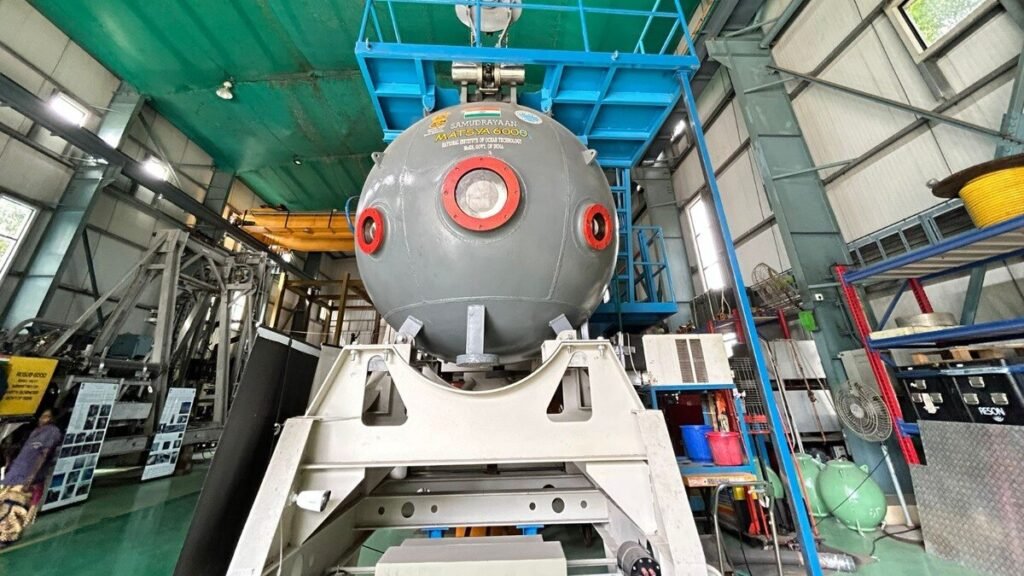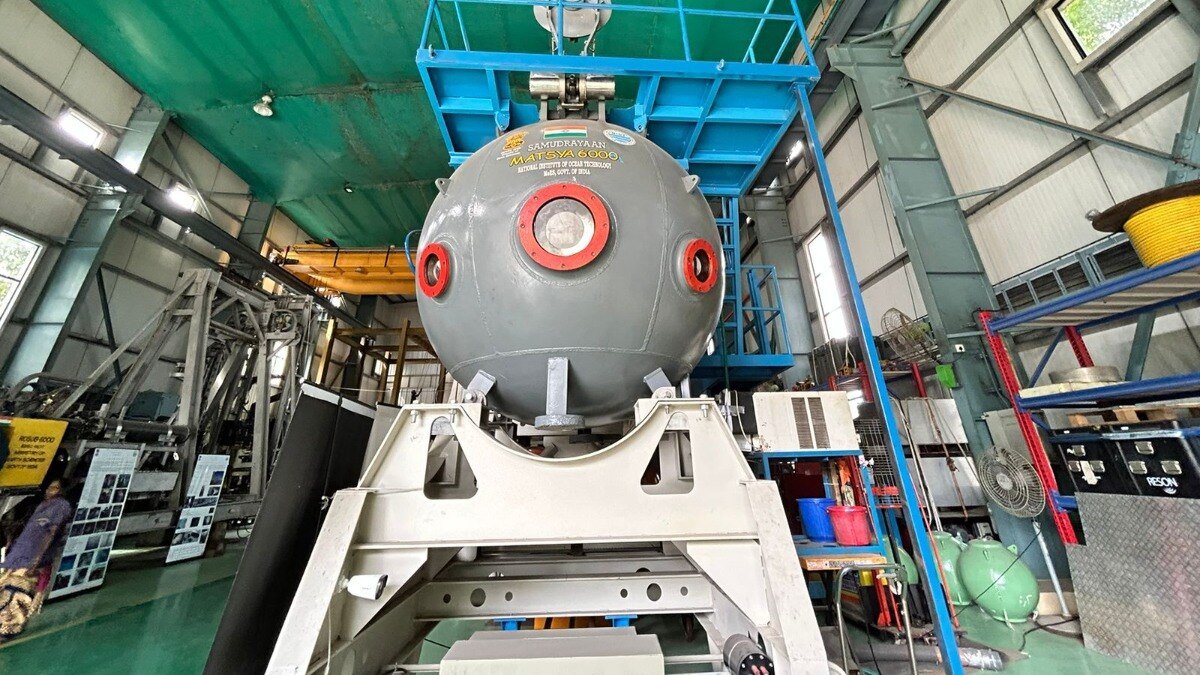Introduction to the Samudrayaan Mission
India, renowned for its advancements in space with missions like Chandrayaan and Mangalyaan, is now diving into the vast, unexplored realm of the deep sea through its bold Samudrayaan Mission. This is India’s first human-crewed deep-sea exploration initiative, aiming to explore ocean depths of up to 6,000 meters.
A major component of the broader Deep Ocean Mission by the Ministry of Earth Sciences, Samudrayaan reflects India’s commitment to unlocking the mysteries of the ocean floor, both for scientific discovery and sustainable development.
What Is the Samudrayaan Mission?
India’s first-ever crewed deep-sea exploration initiative, Samudrayaan aims to send three personnel to a depth of 6,000 meters using an indigenously designed submersible called Matsya‑6000. It’s part of the broader Deep Ocean Mission launched by the Ministry of Earth Sciences

The Matsya‑6000 Submersible
- Crew capacity: 3 people in a 2.1 m diameter titanium sphere rated for 600 bar pressure
- Endurance:
- Normal operations: 12 hours
- Emergency backup: up to 96 hours .
- Equipment & systems: Thrusters, ballast controls, navigation, acoustic communication, robotic arms, oceanographic sensors, and life support including oxygen, batteries, CO₂ scrubbing.
- Development collaboration: Designed by NIOT (Chennai) with support from ISRO, DRDO, and IITM.
Mission Timeline & Progress of Samudrayaan Mission of India
- Concept inception: Proposed in 2019, approved in 2021 .
- Key milestones:
- Oct 2021: Uncrewed test to 6,000 m off Chennai coast.
- Oct 2024: Harbor “wet tests” at ~15 m depth; proves movement, buoyancy, communication systems
- 2025: Planned shallow water trials; final deep-sea crewed dives expected by 2026.
Mission Objectives & Importance
- Scientific Gain
Direct observation and collection of samples from uncharted deep-sea habitats, biodiversity zones, and geological structures . - Resource Exploration
Survey and assess deep-sea minerals including polymetallic nodules rich in manganese, nickel, cobalt, copper, and rare earths in India’s EEZ and Continental Shelf. - Technological Milestone
Showcases India’s capabilities in deep-sea engineering, crewed submersible design, and underwater robotics. - Strategic & Economic Edge
Aligns with the “Blue Economy” vision—including sustainable resource use, ocean literacy, potential tourism, and enhancing India’s global ocean research standing.
Budget & Institutional Support of Samudrayaan Mission of India
- Funding: The Deep Ocean Mission has a ₹4,077 crore (~$500M) budget for 2021–2026; Samudrayaan has received a ₹600 crore boost in FY25.
- Key Institutions:
- NIOT – mission lead and vehicle developer
- ISRO – capsule design expertise
- DRDO – crew safety & food systems
- IITM, NCPOR, among others.
Global Significance
On success, India will join a select group of nations—USA, China, Russia, France, Japan—with crewed submersible capabilities.
Current Status & Next Steps
- Recent success: Harbour wet tests validated basic operations.
- 2025: Shallow-water dives and crew training (by INM) are planned.
- 2026: Anticipated full-depth crewed missions to fulfill mission goals.
Why Samudrayaan Matters
This ambitious mission expands India’s frontiers beyond terrestrial and space boundaries into the last frontier—the deep ocean. It’s a leap toward scientific discovery, technological leadership, sustainable resource management, and strategic autonomy in maritime domains.
Historical Background and Launch Timeline Samudrayaan Mission of India
The conceptual groundwork for Samudrayaan began in 2019, with formal approvals rolling in by 2021. The initiative picked up momentum after successful preliminary uncrewed tests and is now set for major milestones between 2025 and 2026.
Key Milestones:
- 2019: Idea proposed under Deep Ocean Mission umbrella.
- 2021: Project approval by the Union Cabinet.
- 2024: Matsya-6000 underwent wet tests at harbor.
- 2025: Scheduled shallow-water crewed trials.
- 2026: Planned full-depth dive with three crew members.
Objectives of the Samudrayaan Mission of India
The Samudrayaan Mission is multifaceted, serving scientific, economic, and strategic goals:
- Scientific Discovery: Study of unknown marine biodiversity, hydrothermal vents, and deep-sea ecosystems.
- Technological Advancement: Mastering submersible design and crewed underwater navigation.
- Resource Exploration: Survey for polymetallic nodules containing vital rare-earth minerals.
- Strategic Importance: Enhance India’s maritime strength and contribute to its Blue Economy aspirations.
The Matsya-6000 Submersible
Central to the mission is Matsya-6000, an indigenous submersible designed to carry three humans to a depth of 6 km.
Key Specs:
- Structure: 2.1m diameter titanium sphere.
- Pressure Resistance: Withstands up to 600 bars (6000 meters).
- Life Support: 12 hours of operational endurance + 96 hours emergency backup.
- Features: Robotic arms, cameras, navigation aids, oceanographic sensors.
The name “Matsya” symbolizes the mythical fish incarnation of Lord Vishnu—apt for a mission exploring aquatic frontiers.
Technology Behind the Samudrayaan Mission of India
The mission incorporates cutting-edge marine engineering and deep-ocean systems:
- Navigation and Thrusters: For smooth underwater movement.
- Communication Systems: Acoustic telemetry and satellite-linked updates.
- Life Support: CO₂ scrubbers, oxygen reserves, temperature control.
- Robotic Instruments: Arms for sediment sampling, cameras for 3D ocean floor imaging.
These innovations ensure crew safety, mission efficiency, and data accuracy.
Key Institutions Involved
Multiple premier Indian institutions are jointly executing this ambitious project:
| Institution | Role |
|---|---|
| NIOT (Chennai) | Project leadership and submersible design |
| ISRO | Design assistance and structural modeling |
| DRDO | Safety, pressure systems, and food-grade material development |
| IIT Madras & NCPOR | Oceanographic research and simulation analysis |
This national collaboration showcases India’s united strength in ocean science and engineering.
Crew and Training Program
For a mission of such technical depth and physical danger, selecting and training the right crew is paramount. The Samudrayaan mission will involve three specially trained personnel, who must be physically fit, psychologically resilient, and technically adept.
Key Training Highlights:
- Conducted by INM (Indian Navy’s Institute of Naval Medicine).
- High-pressure environment simulations.
- Emergency response and escape training.
- Hands-on navigation and robotic operations.
This rigorous process ensures that the crew can endure extreme pressure, confined spaces, and perform scientific tasks at oceanic depths similar to space missions.
Test Milestones Achieved of Samudrayaan Mission of India
Before sending humans into the deep sea, a series of critical tests have validated Matsya‑6000’s performance:
- Uncrewed Dives (2021–2023)
Demonstrated pressure tolerance and system endurance up to 6,000 meters. - Wet Harbor Tests (2024)
Conducted in shallow harbors to validate buoyancy control, navigation systems, and communication under water. - Upcoming Shallow Water Trials (2025)
Will simulate operational conditions at moderate depths (up to 500 meters) before final mission certification.
These progressive tests are incremental and risk-averse, adhering to international best practices in deep-sea submersion.
Samudrayaan vs Global Deep-Sea Missions
By entering the elite club of countries with crewed deep-sea capabilities, India aligns itself with ocean-exploring powerhouses like:
| Country | Famous Manned Submersibles |
|---|---|
| USA | Alvin (Woods Hole Institute) |
| France | Nautile |
| Russia | Mir-1 and Mir-2 |
| China | Jiaolong and Fendouzhe |
| Japan | Shinkai 6500 |
India’s Matsya‑6000 will be the only such vehicle built entirely indigenously among developing nations—marking a major leap in technological sovereignty.
Exploration of Mineral Resources
One of Samudrayaan’s primary goals is to assess seafloor mineral wealth, especially within India’s Exclusive Economic Zone (EEZ) and Central Indian Ocean Basin.
Key Targets:
- Polymetallic Nodules: Rich in manganese, cobalt, copper, and nickel.
- Rare Earth Elements: Vital for electronics, batteries, and green energy tech.
- Hydrothermal Sulfides: Source of gold, silver, and other metals.
The presence of these resources could potentially reduce India’s dependence on imports and open up avenues for deep-sea mining, with care for ecological balance.
Role in India’s Blue Economy Vision
India’s Blue Economy policy promotes sustainable development of ocean resources. Samudrayaan directly aligns with this vision by:
- Promoting marine technology R&D.
- Strengthening national capabilities in ocean governance.
- Supporting economic sectors like fisheries, renewable energy, and coastal tourism.
- Contributing to UN Sustainable Development Goals (SDG-14) – “Life Below Water”.
It bridges scientific advancement with socioeconomic benefits, making it a model for future ocean exploration missions.
Challenges Faced in Deep Sea Missions
Despite its promise, Samudrayaan faces multiple formidable challenges:
- Technical Challenges
Engineering a submersible to withstand 600 times atmospheric pressure requires advanced metallurgy, design, and control systems. - Physiological Constraints
Crew members must endure isolation, limited mobility, and risk of hypoxia. - Environmental Sensitivities
Deep-sea ecosystems are fragile and largely unknown—exploration must avoid irreversible damage. - Operational Risks
Communication lag, emergency rescues at depth, and navigation in total darkness present real-time threats.
Overcoming these will showcase India’s resilience, innovation, and engineering excellence.
Budget Allocation and Financial Planning
The total Deep Ocean Mission has been allocated ₹4,077 crore (~$500 million), with Samudrayaan receiving ₹600 crore in FY25.
| Component | Budget Allocation |
|---|---|
| Matsya-6000 development | ₹300 crore |
| Oceanographic equipment | ₹120 crore |
| Crew training & safety | ₹80 crore |
| Test & deployment logistics | ₹100 crore |
This funding ensures that India builds and operates its own deep-sea crewed vehicle without foreign dependence, enhancing strategic autonomy.
Expected Timeline of Completion
With successful harbor tests in 2024 and shallow water dives expected in 2025, India is eyeing the final deep sea crewed mission by 2026.
Anticipated Roadmap:
- Mid 2025: Shallow sea dives and final system refinements.
- Late 2025: Crew trials and mission simulation.
- 2026: Full mission to 6,000 meters with three crew members aboard Matsya‑6000.
This timeline puts India on course to become the sixth nation to accomplish such a feat—joining the likes of the US, Russia, and China.
Long-Term Vision Beyond Samudrayaan
Samudrayaan is not the end but the beginning of India’s deep-ocean ambitions. The long-term goals include:
- Regular deep-sea sampling missions.
- Deployment of deep-sea observatories.
- Integration with satellite-ocean data networks.
- Future private-public partnerships for ocean tourism and resource management.
India is building a future where the ocean becomes as accessible as space—with the same level of national pride and scientific curiosity.
FAQs about Samudrayaan Mission of India
Q1. What is the main aim of the Samudrayaan Mission?
The mission aims to explore the deep-sea ecosystem, resources, and biodiversity by sending a crew 6,000 meters below sea level.
Q2. Who is developing the Matsya‑6000 submersible?
The National Institute of Ocean Technology (NIOT) in Chennai is developing the vehicle, with help from ISRO, DRDO, and IITM.
Q3. How many crew members will participate?
Three crew members will dive aboard the Matsya‑6000 for up to 12 hours, with emergency backup for 96 hours.
Q4. When will the mission be completed?
The full crewed deep-sea dive is scheduled for 2026, following successful tests in 2024 and 2025.
Q5. What minerals is the mission looking for?
Polymetallic nodules rich in cobalt, manganese, copper, nickel, and rare earth elements.
Q6. How does this support India’s Blue Economy?
It promotes marine tech, ocean literacy, and strategic use of maritime resources—aligning with India’s Blue Economy policy.
Conclusion
The Samudrayaan Mission of India is a landmark project symbolizing India’s move from space to sea. By exploring the depths of our oceans, the nation is not just uncovering natural wealth but also asserting its technological might and scientific leadership. As Matsya-6000 prepares to dive into the abyss, it brings with it a wave of possibilities—for research, resource security, and a future where the ocean is India’s next scientific frontier.
🔗 External Reference:
Learn more from the Ministry of Earth Sciences official updates on Deep Ocean Mission.
You May Consider :- Operation Sindoor 2.0: India’s Strategic Defense and Military Readiness Against Pakistan
